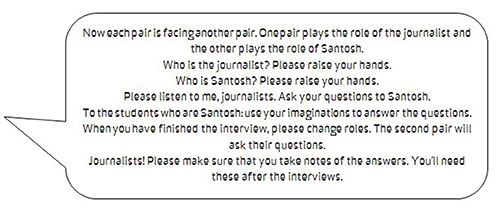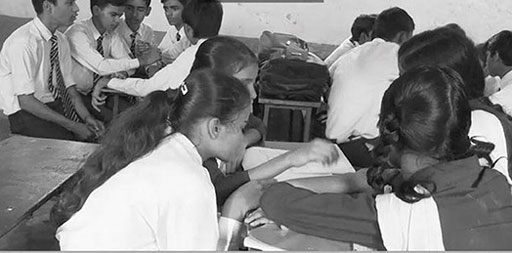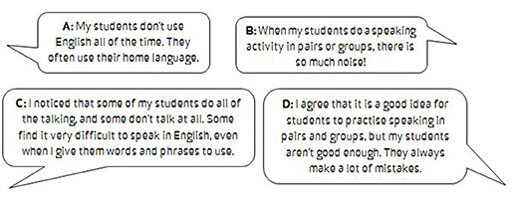2 Creating opportunities for real-life communication in English
It is important to give students as many opportunities to speak in English as possible in English classes. But in many speaking activities, students are reading aloud or speaking set phrases that they have learned. These activities also do not require students to speak their own ideas or formulate sentences to share their thoughts.
When we speak in real life, we usually share information or ideas that are new to the listener. For example, you might give some information about a student to your headteacher, or you might tell your friends about something that happened to you on your way home from work.
Good speaking activities are modelled on real-life situations where information is exchanged. In such activities, students have to use language to communicate what they want to say.
Examples of speaking activities that develop communication skills are role plays, interviews and discussions – see Resource 2 for an example of a role play activity. In the activities and case studies that follow, you will look at interviews and discussions.
Pair or groupwork in which students conduct interviews with each other can be a good way to use English to communicate. One student can pretend that they are a journalist, while the other can be the interviewee (they could be famous movie starts, sports heroes, musicians, a local person, etc. …). While the students are playing roles, they are participating in an activity that is modelled on a real-life situation in which one person asks questions and another one gives a reply to communicate information.
Case Study 2: Mr Sampath helps his students to do interviews in small groups
Mr Sampath teaches English to Class IX at a government secondary school.
I teach Class IX, and we recently read a passage about Santosh Yadav, a woman who struggled against the odds to climb Mount Everest [see the NCERT Class X textbook Beehive, Chapter 8 – ‘Reach to the Top’]. She is a courageous, determined young woman, and I thought it would be interesting to use the character for an interview activity.
After reminding students about the passage, I told them to imagine that they were journalists, and they were going to interview Santosh Yadav, the climber. I asked the whole class to think of some questions they would ask and a few came up with some ideas. I wrote them on the board:
I then organised the class into pairs (with students working with the person sitting next to them) and told them to write as many questions as they could for Santosh. I encouraged them to be imaginative. I gave them a time limit for writing questions – about eight minutes. As they started writing questions I walked around and helped those who needed it, correcting some mistakes, and suggesting more inventive questions, saying:

I quickly made sure that each pair had written some questions, and then I told them to stop writing. I told my class that they were going to do the interviews, and I asked each alternate row to turn around on their benches so that the students faced each other, and gave some more instructions.

Students started the interviews [Figure 3]. I moved to the back of the room to listen to a group. As I listened, I noticed that one girl was not participating – her classmate was answering all of the questions. I told them that they must take it in turns to answer questions, and that her classmate could help her with words when she was stuck.

I then listened to a group in the middle of the room. I noticed that they were using their home language to answer the questions. I asked them why, and they said that they didn’t know a word they wanted to use in English. I gave them the translation of the word, and told them to try to use as much English as they could – even if they didn’t know a word. I also told them to note down any words they didn’t know, to ask me later or look them up in a dictionary.
Then I realised that the room was quite noisy. I saw that some groups were being noisier than the others, so I moved across to them and told them to speak more quietly. Sometimes it is enough to catch the attention of a group and to use a gesture to quieten things down.
I noticed that many students were making mistakes. I knew that if I interrupted, I would discourage them from speaking – and the whole purpose of this activity is to get students speaking in English. Instead, I made a note of some common mistakes and decided that I could review these problems in another class.
After ten minutes I saw that many groups were finishing their interviews, so I decided to end the activity. I started counting down from ten to zero. By the time I reached zero, the groups were quiet, and had stopped talking. I asked students to use their notes from the interview to write a report about Santosh.
Activity 2: Try an interview activity in the classroom
Follow these steps and try using interviews in your classroom the way that Mr Sampath did in Case Study 2. This will allow your students to practise communicating in English:
- Select a person to be interviewed. This could be somebody from a passage in the textbook (as in Case Study 2), a fictional character, or any famous person suggested by the students; for example, a film star, a sports star, a local celebrity and so on. If the character to be interviewed is an interesting one for the students, they are more likely to be motivated.
- Ask the students to give some questions that they might want to ask, and write three to five suggestions on the blackboard. Encourage them to ask questions that they don’t know the answers to, and to use creativity and imagination. Examples might be:
- How many brothers and sisters do you have?
- What did you want to be when you grow up?
- How did you feel when you did [whatever they did]?
- Tell the students to imagine that they are journalists and to write down questions. Give them a time limit of, say, ten minutes.
- Move around the classroom as the students write, checking and correcting work, helping, and encouraging interesting questions.
- Tell alternate rows to turn around so that they are facing the row behind. Tell pairs facing each other to make a group of four. Make sure any extra students are incorporated into a group.
- Tell the students that one pair of each group should take the role of the journalist, while the other pair is the interviewee. Tell them that they should exchange roles once the first interview is finished. Journalists must take notes of the interviews.
- Check that everyone understands their roles and what they need to do. Give a time limit of ten minutes for the interviews.
- As the groups conduct the interviews, move around the room and listen, helping where necessary.
- After around ten minutes, end the activity quickly using some routine (for example, counting down from ten to zero).
Pause for thought There are many benefits to using pair and groupwork. However, they also have their challenges, especially when used with large classes. After trying this activity with your students, think about what happened in your classroom:
|
In Activity 3, you will explore these questions further.
Activity 3: Challenges and possible solutions in using pair and groupwork for speaking activities
Read some teachers’ comments about the challenges of using pair and groupwork for speaking activities. They are marked A, B, C and D:

Now read some advice from some other teachers. Decide which advice goes with which challenge, and write the relevant letter next to it. For example, the first piece of advice helps teachers who are worried about noise (B). When you are ready, check your answers with Resource 3.
| It is up to you to let your students know what an acceptable level of noise is. Move around the room and keep an eye on all the groups and pairs so that you can immediately stop them if some students are getting to loud or not doing the activity. | B |
| Make sure that you provide support for students who are struggling. They may need more help with words or phrases, or more time to plan what they are going to say. | |
| Students could plan with others so that they can help each other. Try to encourage all of your students so that they stay motivated and eager to learn. | |
| Talk to other teachers in the school and your headteacher so that they know why there is noise in your classroom. Make sure that they understand that the noise is a result of active learning and not a lack of discipline. | |
| Don’t worry too much about mistakes. You can make notes and review common problems with the whole class after an activity. | |
| If noise is a problem, agree time limits, or – if you can – go outside to do the activity. | |
| Be positive about mistakes. Remember that the classroom should be a safe place for students to practise – they can learn from their mistakes and rehearse language before they have to use it outside the classroom in ‘real life’. | |
| As you move around the classroom, make notes when students use their home language, and at the end of the activity, you could teach them the English they need. Encourage students to note down the words they don’t know, and to use a dictionary to look the words up in their own time. | |
| Remember that it is natural for students to use their home language or to mix languages. Encourage them to use English as much as they can, but also understand that there are times when students don’t have the language skills in English to express what they want to say, and remember that even some English is better than none. |
1 Pair and groupwork speaking activities

